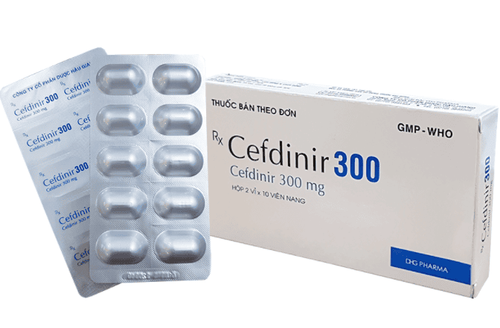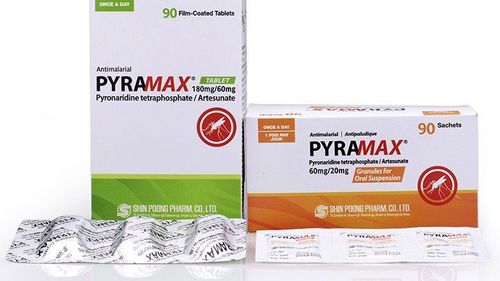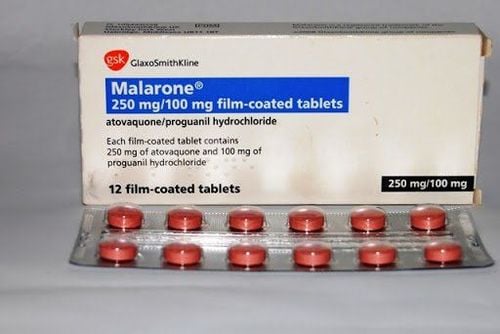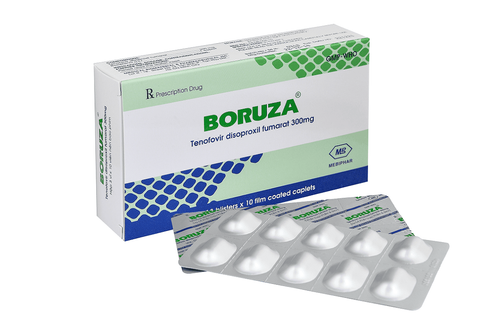This is an automatically translated article.
Atovaquone is an oral suspension that is used to treat Pneumocystis carinii pneumonia in adolescents and adults. So what is Atovaquone drug? how does it use?
1. What are the uses of Atovaquone?
Atovaquone is an antibacterial agent, belonging to the group of antifungal drugs, available as a 5ml oral suspension containing 750 mg of atovaquone.
Atovaquone is prescribed by a doctor for the following cases:
For the treatment or prevention of pneumonia caused by Pneumocystis pneumonia; It is also indicated for the acute oral treatment of mild to moderate Pneumocystis jiroveci (PCP) in patients who are intolerant to TMP-SMX; Plasmodium falciparum malaria; Pneumonia caused by pneumonia Jiroveci; Encephalitis caused by Toxoplasma gondii; Acute, uncomplicated malaria caused by plasmodium falciparum; Mild babesiosis; Mild pneumonia caused by Pneumocystis jiroveci; Moderate babesiosis; Pneumocystis jiroveci pneumonia of moderate severity.
2. How to use the drug Atovaquone
How to take Atovaquone
Atovaquone comes as a suspension (liquid) for oral administration. When Atovaquone is used to treat pneumonia, it is usually taken with meals 2 times a day for 21 days. Take Atovaquone at the same time every day. Do not take more or less or take it more often than prescribed by your doctor. The prescribed dose of Atovaquone should be taken with food. The presence of food, especially high-fat foods, will increase the bioavailability by 2-3 times. If your medicine comes in a bottle, shake the bottle gently before each use to mix the medicine well. Use a measuring spoon or cup to measure the exact amount of liquid, do not use a regular household spoon. Take this medicine until the end of the course as directed by your doctor. Do not stop taking the medicine early even if you feel better. Dosage of Atovaquone:
Adults with Pneumocystis carinii pneumonia:
750 mg each time (equivalent to 5ml), orally twice a day for 21 days. Alternative therapy may be necessary if arterial blood gas values do not improve or worsen after 7 to 10 days of treatment, or if the patient's condition clinically worsens after 4 days. use medicine. Usual Adult Dose for Prophylaxis of Pneumocystis Carinii Pneumonia:
1500 mg (equivalent to 10ml), taken as a single daily dose. Usual Adult Dose for Babesia Infection:
750 mg (equivalent to 5ml), orally twice daily in combination with azithromycin (500 to 600 mg on the first day, followed by a dose of 250 to 600 mg) 600 mg once daily on subsequent days Or 1000 mg (equivalent to 7.5ml), as a single dose daily for 3 days, followed by a single dose of 500 mg once daily for the following days) within from 7 to 10 days. Usual Adult Dose for Malaria:
500 to 750 mg (equivalent to 3.5 to 5ml), given every 12 hours for 7 consecutive days; Atovaquone should be used in combination with other antimalarial drugs. Usual Adult Dose for Toxoplasmosis:
750 mg (5ml) orally every 6 hours for 2 to 6 months. The same dose every 6-8 hours is used for the maintenance treatment of Toxoplasma infections. Usual Pediatric Dose for Pneumocystis carinii pneumonia:
1 month to 12 years: 20 mg/kg orally twice daily. 13 years and older: 750 mg (equivalent to 5ml), orally twice daily for 21 days. Maximum dose: 1500mg/day (equivalent to 10ml). Usual Pediatric Dose for Pneumocystis Carinii Pneumonia Prophylaxis:
1-3 months of age: 30 mg/kg orally once daily. 4 months to 2 years: 45 mg/kg, orally once a day. 2-12 years: 30 mg/kg, orally once a day. 13 years and older: 1500 mg (equivalent to 10ml) orally once a day. Maximum dose: 1500mg/day (equivalent to 10ml). Usual Pediatric Dose for Babesia
1-12 years: 20 mg/kg orally twice daily along with azithromycin (12 mg/kg, once daily) for 7 to 10 days. 13 years and older: 750 mg (5ml equivalent), orally twice daily with azithromycin (500-600 mg on the first day, followed by a dose of 250 to 600 mg once daily for the following days, or 1000mg once daily for 3 days, followed by a dose of 500mg once daily for the following days) for 7-10 days. Maximum dose: 1500mg/day (equivalent to 10ml).
3. Contraindications of Atovaquone
Patients who are allergic to any ingredient or excipients of Atovaquone Pregnancy: Atovaquone should not be used during pregnancy unless the benefit of treatment to the mother outweighs any risk. What could happen to the unborn baby? Lactation: It is not known whether Atovaquone is excreted in human milk and therefore should not be used in nursing women.
4. Notes when using Atovaquone
Diarrhea at the start of treatment has been shown to be associated with lower plasma concentrations of Atovaquone. These in turn correlate with high rates of therapy failure and lower survival rates. Therefore, alternative therapies should be considered for these patients.
Patients receiving concomitant Tetracycline should be closely monitored. Concomitant use of Atovaquone and Efavirenz or enhanced protease inhibitors should be avoided whenever possible.
Some other notes:
Simultaneous use of Atovaquone and Rifampicin is not recommended. Concomitant use of Metoclopramide is not recommended. Atovaquone may increase the concentration of Etoposide and its metabolites. No data are available on immunocompromised patients without HIV being treated with PCP. There is no clinical experience with the treatment of Atovaquone in elderly patients. Therefore, use in the elderly should be closely monitored. The drug should not be used for more than 7 days in young children (under 3 years of age) due to an increased cumulative risk. The drug should be used with caution and only when absolutely necessary, especially in pregnant or lactating patients or patients with severe hepatic or renal impairment because of the high risk of accumulation and increased toxicity (acidosis). metabolism ). Patients with pneumonia should be carefully evaluated by their physicians for causes other than PCP and should be treated with additional medications as appropriate. Atovaquone is not effective against fungal, viral, bacterial and Mycobacterium diseases. Before taking Atovaquone you should: Tell your doctor and pharmacist if you are allergic to Atovaquone or any of the ingredients in the suspension; are taking other prescription and over-the-counter medications; have or have ever had an intestinal disorder, stomach disorder or liver disease; you are pregnant, plan to become pregnant, or are breast-feeding.
5. Atovaquone side effects
Call 911 or go to the nearest medical facility right away if you have any of these signs of an allergic reaction: difficulty breathing; rash; swelling of the face, tongue, lips, or throat. Tell your doctor right away if you have any of the following serious side effects:
Skin that bruises or bleeds very easily, unusual weakness; Fever or flu symptoms; Appearance of white patches in the mouth or throat; Cough gets worse; Symptoms of bronchospasm (chest tightness, shortness of breath, wheezing); Sore throat, fever, and headache with severe blistering, peeling, or red skin rash; Loss of appetite, nausea, dark urine, clay-colored stools, jaundice or yellow eyes. Less serious side effects may include:
Nausea, or actual vomiting, stomach pain or mild abdominal discomfort; Constipation, diarrhea; Headache; Possible weakness, dizziness; Muscle pain; mild skin rash; Perspire; Have sleep problems (insomnia). Store the medicine at a temperature of about 15-25°C. Keep Atovaquone and all other medicines out of the reach of children, never share your medicine with others, and only use it under your doctor's prescription.
Please dial HOTLINE for more information or register for an appointment HERE. Download MyVinmec app to make appointments faster and to manage your bookings easily.
References: go.drugbank.com, medlineplus.gov













